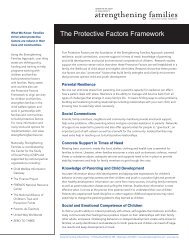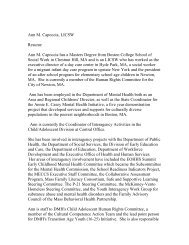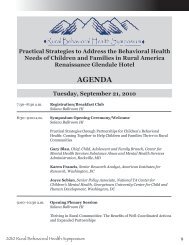Training Institutes 2012 - National Technical Assistance Center for ...
Training Institutes 2012 - National Technical Assistance Center for ...
Training Institutes 2012 - National Technical Assistance Center for ...
You also want an ePaper? Increase the reach of your titles
YUMPU automatically turns print PDFs into web optimized ePapers that Google loves.
RESOURCES<br />
System of Care Concept and Philosophy<br />
DEFINITION<br />
A system of care is: A spectrum of effective, community-based services and supports <strong>for</strong> children and youth with<br />
or at risk <strong>for</strong> mental health or other challenges and their families, that is organized into a coordinated network, builds<br />
meaningful partnerships with families and youth, and addresses their cultural and linguistic needs, in order to help them<br />
to function better at home, in school, in the community, and throughout life.<br />
CORE VALUES<br />
Systems of care are:<br />
1. Family driven and youth guided, with the strengths and needs of the child and family determining the types and mix<br />
of services and supports provided.<br />
2. Community based, with the locus of services as well as system management resting within a supportive, adaptive<br />
infrastructure of structures, processes, and relationships at the community level.<br />
3. Culturally and linguistically competent, with agencies, programs, and services that reflect the cultural, racial,<br />
ethnic, and linguistic differences of the populations they serve to facilitate access to and utilization of appropriate<br />
services and supports.<br />
GUIDING PRINCIPLES<br />
Systems of care are designed to:<br />
1. Ensure availability of and access to a broad, flexible array of effective, evidence-in<strong>for</strong>med, community-based<br />
services and supports <strong>for</strong> children and their families that addresses their physical, emotional, social, and educational<br />
needs, including traditional and nontraditional services as well as in<strong>for</strong>mal and natural supports.<br />
2. Provide individualized services in accordance with the unique potential and needs of each child and family, guided<br />
by a strengths-based, wraparound service planning process and an individualized service plan developed in true<br />
partnership with the child and family.<br />
3. Deliver services and supports within the least restrictive, most normative environments that are clinically appropriate.<br />
4. Ensure that families, other caregivers, and youth are full partners in all aspects of the planning and delivery of their<br />
own services and in the policies and procedures that govern care <strong>for</strong> all children and youth in their communities,<br />
states, territories, tribes, and Nation.<br />
5. Ensure cross-system collaboration, with linkages between child-serving agencies and programs across<br />
administrative and funding boundaries and mechanisms <strong>for</strong> system-level management, coordination, and<br />
integrated care management.<br />
6. Provide care management or similar mechanisms to ensure that multiple services are delivered in a coordinated and<br />
therapeutic manner and that children and their families can move through the system of services in accordance with<br />
their changing needs.<br />
7. Provide developmentally appropriate mental health services and supports that promote optimal social and<br />
emotional outcomes <strong>for</strong> young children and their families in their homes and community settings.<br />
8. Provide developmentally appropriate services and supports to facilitate the transition of youth to adulthood<br />
and to the adult-service system as needed.<br />
9. Incorporate or link with mental health promotion, prevention, and early identification and intervention to improve<br />
long-term outcomes, including mechanisms to identify problems at an earlier stage and mental health promotion<br />
and prevention activities directed at all children and adolescents.<br />
10. Incorporate continuous accountability mechanisms to track, monitor, and manage the achievement of system of<br />
care goals; fidelity to the system of care philosophy; and quality, effectiveness, and outcomes at the system level,<br />
practice level, and child and family level.<br />
11. Protect the rights of children, youth, and families and promote effective advocacy ef<strong>for</strong>ts.<br />
12. Provide services and supports without regard to race, religion, national origin, gender, gender expression, sexual<br />
orientation, physical disability, socioeconomic status, geography, language, immigration status, or other<br />
characteristics; services should be sensitive and responsive to these differences.<br />
Stroul, B., Blau, G., & Friedman, R. (2010). Updating the system of care concept and philosophy. Washington, DC: Georgetown<br />
University <strong>Center</strong> <strong>for</strong> Child and Human Development, <strong>National</strong> <strong>Technical</strong> <strong>Assistance</strong> <strong>Center</strong> <strong>for</strong> Children’s Mental Health.<br />
160 <strong>Training</strong> <strong>Institutes</strong> 2010













